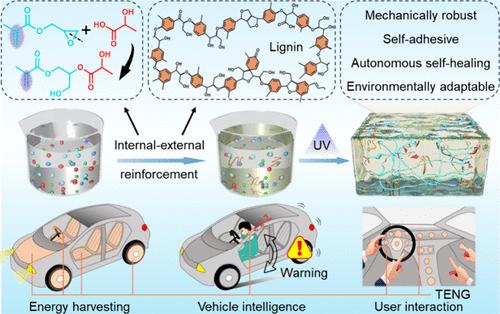Mechanically Resilient, Self-Healing, and Environmentally Adaptable Eutectogel-Based Triboelectric Nanogenerators for All-Weather Energy Harvesting and Human–Machine Interaction
IF 16
1区 材料科学
Q1 CHEMISTRY, MULTIDISCIPLINARY
引用次数: 0
Abstract
Triboelectric nanogenerators (TENGs) have garnered significant attention for mechanical energy harvesting, self-powered sensing, and human–machine interaction. However, their performance is often constrained by materials that lack sufficient mechanical robustness, self-healing capability, and adaptability to environmental extremes. Eutectogels, with their inherent ionic conductivity, thermal stability, and sustainability, offer an appealing alternative as flexible TENG electrodes, yet they typically suffer from weak damage endurance and insufficient self-healing capability. To overcome these challenges, here, we introduce an internal-external dual reinforcement strategy (IEDRS) that enhances internal bonding dynamics within the eutectogel matrix, composed of glycidyl methacrylate and deep eutectic solvent, and integrates plant-derived lignin as an external reinforcer. Notably, the resultant eutectogel, named GLCL, exhibits appealing collection merits including superior mechanical robustness (1.53 MPa tensile stress and 1.85 MJ/m3 toughness), ultrastrong adhesion (4.76 MPa), high self-healing efficiency (84.7%), and significant environmental adaptability (−40 to 100 °C). These improvements ensure that the assembled triboelectric nanogenerator (GLCL-TENG) produces stable and robust electrical outputs, maintained even under dynamic and postdamage conditions. Additionally, the GLCL-TENG exhibits significant extreme environmental tolerance and durability, maintaining high and consistent electrical outputs over a wide temperature range (−40 to 100 °C) and throughout 10,000 cycles of repeated contact-separation. Leveraging these robust performances, the GLCL-TENG excels in all-weather biomechanical energy harvesting and accurate individual motion detection and functions as a self-powered interface for wireless vehicular control. This work presents a viable material design strategy for developing tough and self-healing eutectogel electrodes, emphasizing the potential application of TENGs in all-weather smart vehicles.

用于全天候能量收集和人机交互的机械弹性、自我修复和环境适应性共聚凝胶摩擦电纳米发电机
摩擦电纳米发电机(TENGs)在机械能收集、自供电传感和人机交互方面获得了极大的关注。然而,它们的性能往往受到材料的限制,这些材料缺乏足够的机械稳健性、自我修复能力和对极端环境的适应性。共析凝胶具有固有的离子导电性、热稳定性和可持续性,是柔性TENG电极的一个有吸引力的选择,但它们通常存在较弱的损伤耐久性和自我修复能力不足的问题。为了克服这些挑战,在这里,我们引入了一种内外双重增强策略(IEDRS),该策略增强了由甲基丙烯酸甘油酯和深共晶溶剂组成的共聚基基质内的内部键合动力学,并整合了植物衍生木质素作为外部增强剂。值得注意的是,所得到的共聚物,被命名为GLCL,具有吸引人的收集优点,包括优越的机械坚固性(1.53 MPa拉伸应力和1.85 MJ/m3韧性),超强附着力(4.76 MPa),高自愈效率(84.7%)和显著的环境适应性(- 40至100°C)。这些改进确保组装的摩擦电纳米发电机(GLCL-TENG)产生稳定和强大的电力输出,即使在动态和后损坏条件下也能保持。此外,GLCL-TENG具有显著的极端环境耐受性和耐久性,在宽温度范围(- 40至100°C)和10,000次重复触点分离循环中保持高且一致的电输出。利用这些强大的性能,GLCL-TENG在全天候生物力学能量收集和精确的个人运动检测方面表现出色,并可作为无线车辆控制的自供电接口。这项工作提出了一种可行的材料设计策略,用于开发坚韧和自修复的共晶电极,强调了TENGs在全天候智能车辆中的潜在应用。
本文章由计算机程序翻译,如有差异,请以英文原文为准。
求助全文
约1分钟内获得全文
求助全文
来源期刊

ACS Nano
工程技术-材料科学:综合
CiteScore
26.00
自引率
4.10%
发文量
1627
审稿时长
1.7 months
期刊介绍:
ACS Nano, published monthly, serves as an international forum for comprehensive articles on nanoscience and nanotechnology research at the intersections of chemistry, biology, materials science, physics, and engineering. The journal fosters communication among scientists in these communities, facilitating collaboration, new research opportunities, and advancements through discoveries. ACS Nano covers synthesis, assembly, characterization, theory, and simulation of nanostructures, nanobiotechnology, nanofabrication, methods and tools for nanoscience and nanotechnology, and self- and directed-assembly. Alongside original research articles, it offers thorough reviews, perspectives on cutting-edge research, and discussions envisioning the future of nanoscience and nanotechnology.
 求助内容:
求助内容: 应助结果提醒方式:
应助结果提醒方式:


